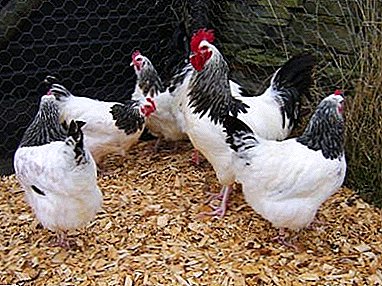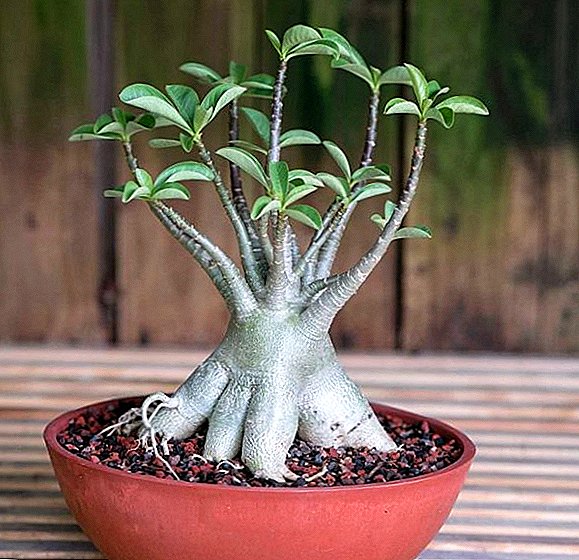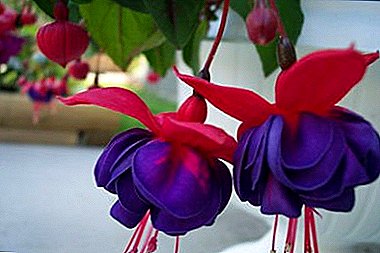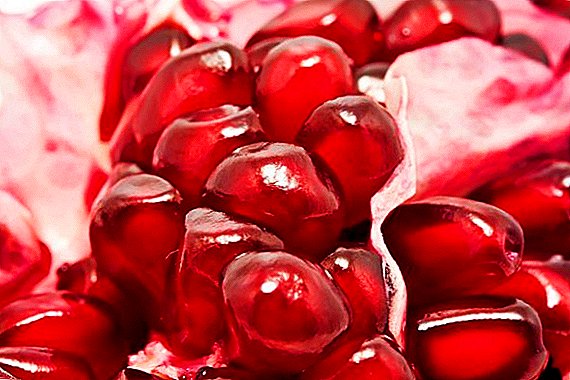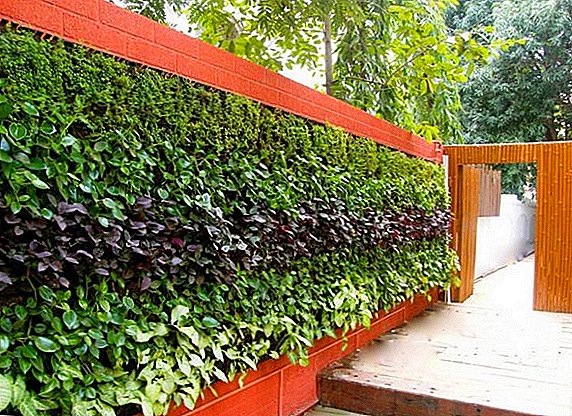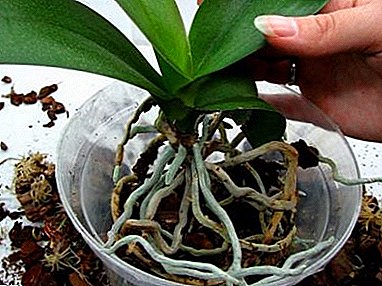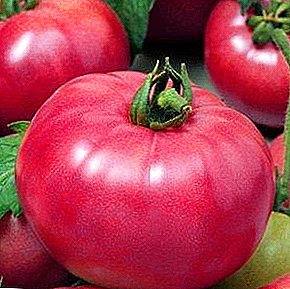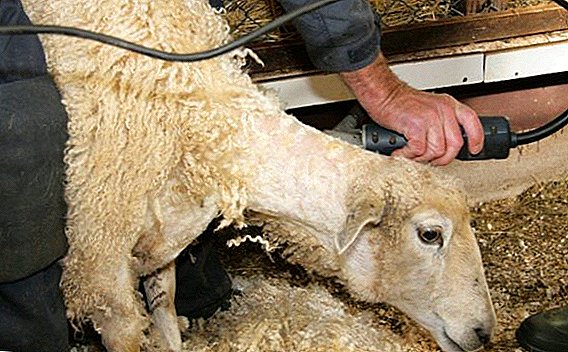
Hibiscus belongs to the vast genus of herbaceous plants of the family Malvaceae, whose tropical and subtropical latitudes are native.
In our latitudes, this plant is grown as indoor or greenhouse. But there are certain species that in temperate climates can grow in open ground.
About suitable varieties, planting hibiscus in open ground and the nuances of caring for him and will be discussed in this article. And also in the article we learn how to properly propagate this plant.
What varieties are suitable for growing in the garden?
To those varieties that calmly tolerate temperature drops, frosts, long rains, can be attributed hibiscus garden (Syrian) and hibiscus hybrid, which can both be planted in the country and they can decorate the landscape of a plot of a country house.
Hibíscus syríacus (Syrian bush)
- Diana;
- Wielite Ilar Double;
- Pink Giant;
- Carneus Plenus;
- Joan of Arc.

Hibiscus hybridus (hybrid herbaceous)
- Youth;
- Late;
- Pale pink;
- Pink and porcelain.

Flower in the photo
Blooming hibiscus looks at the same time very gently and thoroughly:





Is it possible to plant in the spring outside?
Planting in the open ground in the springafter the earth warms up deep enough and warm weather sets in. Many people living in northern latitudes are afraid to start a Syrian hibiscus, because it can freeze. This problem is solved if in the first year of life the plant overwinters indoors, and then returns to the place allotted to it in the garden.
How to choose a suitable place in the country?
- Lighting. Hibiscus loves light, so the best place for it on the plot is a well-lit playground, but without direct sunlight, which can cause leaf burns.
- Temperature. Garden hibiscus grows in open ground, so it accepts any temperature in the warm season. But it is important that the hibiscus be planted in a place that is protected from wind and drafts. But in order for hibiscus to survive the winter with its frosts, you need to take care of it.
If winter is expected, the maximum temperature of which will be -15 ° C, then a frame should be built around the plant, onto which the spanbond or agrotex should be pulled. If winter is expected to be harsh, then it is better not to risk it and, having dug up hibiscus, give it the opportunity to spend the winter in the basement or in another cool room.
- Priming. The main requirement for the soil - it must be nutritious, light, permeable. Any peat-based substrate will meet these characteristics. For planting hibiscus, you can use a mixture of garden soil, peat, sand in the ratio of 2: 4: 1. You can and another mixture: turf, leaf soil, humus, coarse sand in a ratio of 2: 2: 1: 1. As an option: 5% perlite, 45% bark from hardwood, 50% peat.
- Soil preparation. Pit for planting should be 2 times the volume of the root system of the plant. The bottom layer is drainage (broken brick), its height must be at least 15 cm. The next layer 10 cm high is sand. Next - 15 cm compost. Top layer - 15 cm - sand. After placing the root system of the plant in the planting pit, the whole space is filled with soil.
Reference! The best neighbors for hibiscus on the plot - rose and lavender. With a rose, they have the same requirements for the composition of the soil, and lavender will not only set off hibiscus favorably, but also be an excellent protection against aphids, which does not tolerate lavender smell.
Breeding methods
Multiply hibiscus in the garden can be a list of ways, you just need to choose an available option and get acquainted with a detailed guide on how to plant a plant.
Cuttings
 Step by step landing instructions:
Step by step landing instructions:
- Prepare everything you need:
- container of dark plastic or glass;
- cutting;
- activated carbon tablet;
- some growth stimulant;
- greenhouse
- Capacity to fill the distilled water at room temperature (2/3).
- Add an activated carbon tablet to the water and dissolve the root formation stimulator in it.
- Put the cutting in the water.
- Above the escape tank must be covered with a greenhouse.
- Place the vessel in a warm (+ 20С - + 25С) and bright place (but without direct sunlight).
- Sometimes a greenhouse needs to be opened, shaking off a drop of condensate from its walls.
- After the roots grow to 2 - 3 cm, they can be planted in the ground.
Layering
Step by step landing instructions:
- Prepare everything you need:
- sharp garden knife;
- a piece of plastic;
- "Kornevin";
- sphagnum moss;
- polyethylene film.
- Choose a healthy, half-lignified branch without visible damage.
- Use a garden knife to make a cut of the bark, after removing all the leaves from this place.
- To prevent the overgrowth of the incision and remain ajar, you need to slip a small piece of plastic into it.
- The incision site should be dragged with a root formation stimulator and wound with moistened moss.
- Moss need to wrap a film and a strong thread.
- If the moss is dry, then it must be watered using a medical syringe.
- When young roots will be visible through the film (after 2 - 3 months), the plant can be separated.
Inoculation
Step by step landing instructions:
 Prepare everything you need for vaccination:
Prepare everything you need for vaccination:- sharp garden knife;
- blade;
- rooted cuttings as grafts;
- polyethylene film;
- adult not old plant as a stock.
- Cut at the desired height of the stock must be split in the center with a knife.
- Scion graft must be wedge-shaped.
- Paste the scion graft into the cleft.
- Place vaccinations tightly wrap with plastic wrap, firmly fixing it.
Seeds
Step by step landing instructions:
- Prepare necessary for sowing:
- container;
- substrate;
- drainage;
- seeds;
- water spray;
- glass or plastic film.
- The bottom of the container is filled with drainage, then - a layer of wet soil.
- Seeds are distributed over the surface at a distance of 0.5 cm from each other, and a thin layer of substrate is sprinkled on top, so that the seeds are 5 mm deep.
- Liberally moisten the top layer of the spray bottle.
- The pot is covered with glass or polyethylene, placed in a warm, bright place, but without direct sunlight. Recommended temperature of keeping is + 25С - + 27С. The first shoots will appear in 2 - 3 weeks.
- It is necessary to maintain constant humidity in the greenhouse, do not forget to air it and regularly spray seeds and soil.
- When the seedlings have the first leaves, they need to be seated in individual pots.
- In mid-May, seedlings are planted in open ground.
Dividing bush
 Step by step landing instructions:
Step by step landing instructions:
- Prepare everything you need:
- sharp knife;
- pruner
- Dig a bush.
- Carefully remove the ground from the roots (it is better to wash it off with water).
- Each trunk is separated with a knife so that each of them has a part of the roots (at least 1 - 2 roots 1 - 3 mm long).
- The pruning shears need to prune all the broken parts of the roots.
- Land in the pre-prepared landing pits.
- How to grow indoor hibiscus from seed?
- Reproduction of hibiscus cuttings at home.
When to feed and trim?
Attention! If the hibiscus was planted in the fall, you should also mulch the soil around the trunk of the sapling and tie it with spruce fir or sackcloth with deadwood.
Hibiscus varieties grown in the open field, quite unpretentious and do not require special care. Systematic loosening of the topsoil, removal of weeds, regular watering (in hot and dry summer watering should be daily) - this is what the plant needs. Twice a month, from June to September, garden hibiscus should be fed with fertilizers with a high content of nitrogen and phosphorus, and in the fall with fertilizers with potassium. Do not forget about regular pruning.
What if the plant does not survive?
- Rooted stalk fades after transplanting into the ground. When planting a young plant, its root system was disrupted. Hibiscus will have to be cut again, since there is practically no chance of survival for such a cutting. It is possible to prevent such a phenomenon if the transplanting is done by transferring the plant: remove the plant from the old pot and, without brushing off the earthen clod, place it in the earthen hole.
- The plant did not bloom in the expected time. For systematic and abundant flowering garden hibiscus need regular pruning.
- The young garden hibiscus shows signs of infectious diseases (decay, powdery spots, etc.). For the prevention of this phenomenon, it is recommended to disinfect the soil, the pot into which the cuttings will be planted (fungicide treatment, heat treatment). You can also seed, before dunk in a solution of growth stimulator, briefly immerse in a weak solution of potassium permanganate.
Despite its exotic origin, hibiscus has long become "its" in Russian latitudes. With a little effort, every grower can grow and propagate this plant., bringing to the design of his backyard a bit of exotic hot countries.


 Prepare everything you need for vaccination:
Prepare everything you need for vaccination: